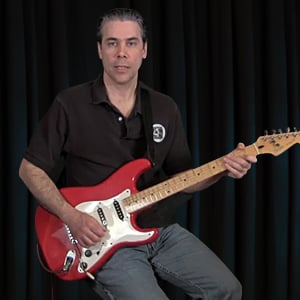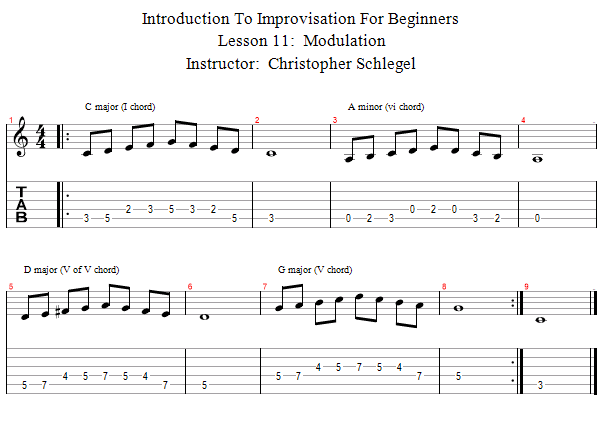- Introduction
- Identifying The Key Signature
- Playing The Major Scale In Time
- Major Scale Play Along
- Targeting Chord Tones
- Chord Tones Play Along
- Using The Scale And Targeting Chord Tones
- Melody Play Along
- Melody An Octave Higher
- Octave Higher Melody Play Along
- Modulation
- Modulation Melody Play Along
- Modulation An Octave Higher
- Octave Higher Modulation Melody Play Along
- Conclusion
Modulation
Sometimes you will find the notes of the chords do not all fit in one scale. So, start by looking for a major or minor scale that contains most of them. Then look for the chord(s) that make for the exception. This is frequently a modulation chord; that calls for altering the scale just enough to accomodate the odd note. Let's use the D major chord as a modulation in our example. Example:
C major: c, e, g
A minor: a, c, e
F major: f, a, c
G major: g, b, d
D major: d, f-sharp, a
Alphabetically: a, b, c, d, e, f, f-sharp, g, a. If you remove the f-sharp and you still have the C major scale: c, d, e, f, g, a, b, c.
So we have the C major or A minor scale with one extra note, the f-sharp. The C major scale will work fine, of course for all the chords until you get to the D major chord. When that D major chord happens though, you will want to alter the notes of the scale to reflect this:
Alphabetically: a, b, c, d, e, f-sharp, g, a. Or: c, d, e, f-sharp, g, a, b, c.
Notice that this can be seen as either a C major scale with an f-sharp, or the G major scale. Either way you chose to look at it, play those notes when the D major chord happens, emphasizing the chord tones d, f-sharp and a. When the song goes back to C major, A minor, F major, or G major, then return to using the f natural as is in the unaltered C major scale!

- Styles:
- Any Style
- Difficulty:
-
